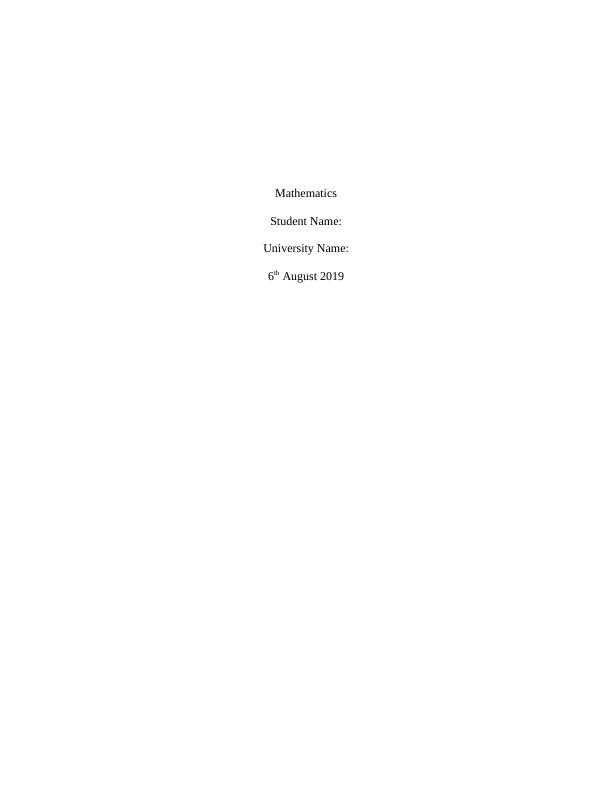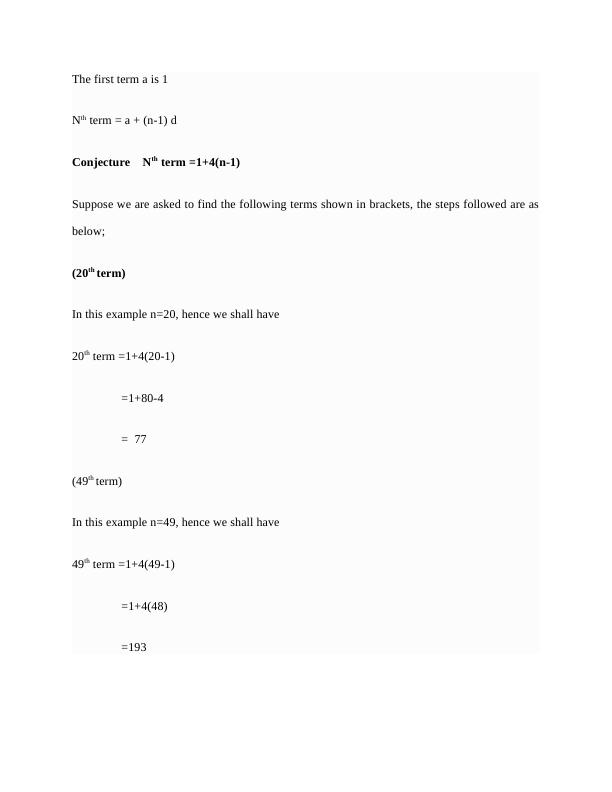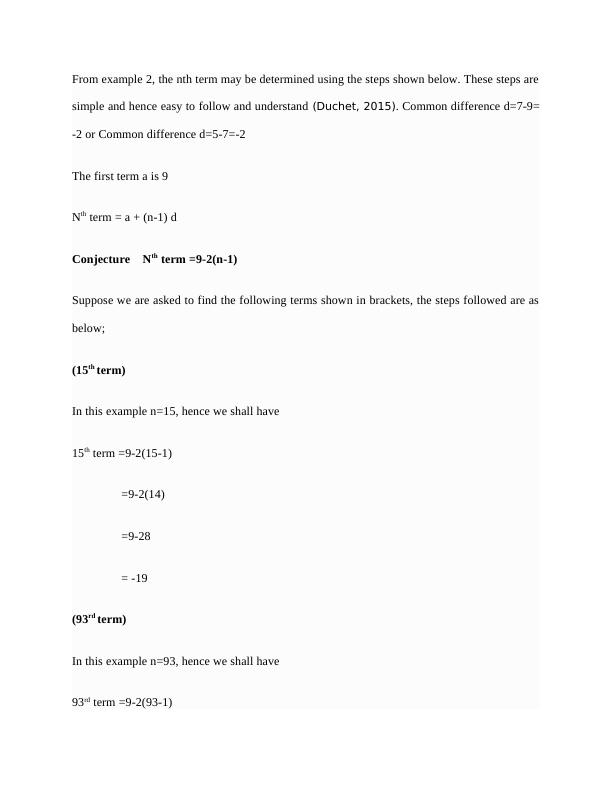Patterns, Sequences and Series in Mathematics
Added on 2022-10-12
22 Pages3098 Words274 Views
Mathematics
Student Name:
University Name:
6th August 2019
Student Name:
University Name:
6th August 2019

PATTERNS
When a group of numbers is following a pattern depending on a specific rule then it qualifies
to be a sequence. There are different types of pattern that we shall have a look at.
The differences arise as a result of their definitions.
1. Arithmetic Sequence
An arithmetic sequence is where the difference between any two consecutive terms is a
constant. This difference is called common difference and it can be positive, negative or
fraction (Bayne, 2012). To get the common difference the succeeding term is subtracted from
the term before it in the sequence. It is worth noting that the difference between the two
consecutive terms must always be the same for the sequence to qualify as arithmetic sequence.
When the sequence has reducing terms the common difference will always be negative because
the succeeding term will be less than the term before it making their difference to be negative.
Example 1
1, 5, 9......................................
Example 2
9, 7, 5, 3, 1......................................
From example 1, the nth term may be determined using the steps shown below. These steps are
simple and hence easy to follow and understand (Bourbaki, 2015). Common difference d=5-
1= 4 or Common difference d=9-5=4
When a group of numbers is following a pattern depending on a specific rule then it qualifies
to be a sequence. There are different types of pattern that we shall have a look at.
The differences arise as a result of their definitions.
1. Arithmetic Sequence
An arithmetic sequence is where the difference between any two consecutive terms is a
constant. This difference is called common difference and it can be positive, negative or
fraction (Bayne, 2012). To get the common difference the succeeding term is subtracted from
the term before it in the sequence. It is worth noting that the difference between the two
consecutive terms must always be the same for the sequence to qualify as arithmetic sequence.
When the sequence has reducing terms the common difference will always be negative because
the succeeding term will be less than the term before it making their difference to be negative.
Example 1
1, 5, 9......................................
Example 2
9, 7, 5, 3, 1......................................
From example 1, the nth term may be determined using the steps shown below. These steps are
simple and hence easy to follow and understand (Bourbaki, 2015). Common difference d=5-
1= 4 or Common difference d=9-5=4

The first term a is 1
Nth term = a + (n-1) d
Conjecture Nth term =1+4(n-1)
Suppose we are asked to find the following terms shown in brackets, the steps followed are as
below;
(20th term)
In this example n=20, hence we shall have
20th term =1+4(20-1)
=1+80-4
= 77
(49th term)
In this example n=49, hence we shall have
49th term =1+4(49-1)
=1+4(48)
=193
Nth term = a + (n-1) d
Conjecture Nth term =1+4(n-1)
Suppose we are asked to find the following terms shown in brackets, the steps followed are as
below;
(20th term)
In this example n=20, hence we shall have
20th term =1+4(20-1)
=1+80-4
= 77
(49th term)
In this example n=49, hence we shall have
49th term =1+4(49-1)
=1+4(48)
=193

From example 2, the nth term may be determined using the steps shown below. These steps are
simple and hence easy to follow and understand (Duchet, 2015). Common difference d=7-9=
-2 or Common difference d=5-7=-2
The first term a is 9
Nth term = a + (n-1) d
Conjecture Nth term =9-2(n-1)
Suppose we are asked to find the following terms shown in brackets, the steps followed are as
below;
(15th term)
In this example n=15, hence we shall have
15th term =9-2(15-1)
=9-2(14)
=9-28
= -19
(93rd term)
In this example n=93, hence we shall have
93rd term =9-2(93-1)
simple and hence easy to follow and understand (Duchet, 2015). Common difference d=7-9=
-2 or Common difference d=5-7=-2
The first term a is 9
Nth term = a + (n-1) d
Conjecture Nth term =9-2(n-1)
Suppose we are asked to find the following terms shown in brackets, the steps followed are as
below;
(15th term)
In this example n=15, hence we shall have
15th term =9-2(15-1)
=9-2(14)
=9-28
= -19
(93rd term)
In this example n=93, hence we shall have
93rd term =9-2(93-1)

= 9 - 2(92)
=9-184
= -175
Applications
In geography, it is applied in calculating the time taken between eruptions by Old
faithful (natural geyser).
In mathematics suppose you are in a traffic ,it is used to predict the arrival of the next bus
if the movement of the traffic is uniform (Falcon, 2013).
2. Geometric Sequence
With geometric sequence the numbers follow a pattern where the next number in the sequence
can be determined by multiplying the previous term by a constant. The constant is called a
common ratio which can either be positive, negative or fraction. To get the common ratio the
succeeding term is divided by the term before it in the sequence (Gaughan, 2014). It is worth
noting that the ratio between the two consecutive terms must always be the same for the
sequence to qualify as geometric sequence.
When the sequence has reducing terms the common ratio will always be less than one because
the succeeding term will be less than the term before it making their ratio to be less than one.
On the other hand the sequence will have negative common ratio whenever the terms have
alternating signs.
=9-184
= -175
Applications
In geography, it is applied in calculating the time taken between eruptions by Old
faithful (natural geyser).
In mathematics suppose you are in a traffic ,it is used to predict the arrival of the next bus
if the movement of the traffic is uniform (Falcon, 2013).
2. Geometric Sequence
With geometric sequence the numbers follow a pattern where the next number in the sequence
can be determined by multiplying the previous term by a constant. The constant is called a
common ratio which can either be positive, negative or fraction. To get the common ratio the
succeeding term is divided by the term before it in the sequence (Gaughan, 2014). It is worth
noting that the ratio between the two consecutive terms must always be the same for the
sequence to qualify as geometric sequence.
When the sequence has reducing terms the common ratio will always be less than one because
the succeeding term will be less than the term before it making their ratio to be less than one.
On the other hand the sequence will have negative common ratio whenever the terms have
alternating signs.

Example 1
2, 4, 8......................................
Example 2
125, 25, 5, 1......................................
From example 1, the nth term may be determined using the steps shown below. These steps are
simple and hence easy to follow and understand. Common ratio r= 8
4 =2 or Common ratio 4
2 =2
The first term a is 2
Nth term = arn-1
Conjecture Nth term= 2(2) n-1
Suppose we are asked to find the following terms shown in brackets, the steps followed are as
below;
(8th term)
In this example n=8, hence we shall have
Nth term= 2(2) n-1
8th term =2(2)8-1
=2(2)7
2, 4, 8......................................
Example 2
125, 25, 5, 1......................................
From example 1, the nth term may be determined using the steps shown below. These steps are
simple and hence easy to follow and understand. Common ratio r= 8
4 =2 or Common ratio 4
2 =2
The first term a is 2
Nth term = arn-1
Conjecture Nth term= 2(2) n-1
Suppose we are asked to find the following terms shown in brackets, the steps followed are as
below;
(8th term)
In this example n=8, hence we shall have
Nth term= 2(2) n-1
8th term =2(2)8-1
=2(2)7

End of preview
Want to access all the pages? Upload your documents or become a member.
Related Documents
Series Definition & Meaninglg...
|11
|821
|16
Vector and Arithmetic Sequences Problem Solutionslg...
|4
|692
|339
Rows and Columns, Arithmetic and Geometric Progressions - Deskliblg...
|8
|1088
|219
Theory in practical computing scenarios PDFlg...
|4
|469
|229
MTH/220T: College Algebra | Arithmetic Sequencelg...
|3
|285
|17
Sequences and Series Problemslg...
|3
|718
|42
